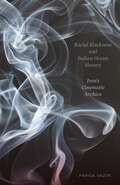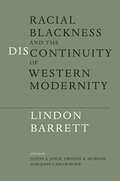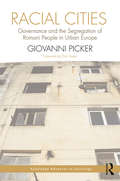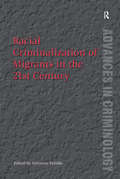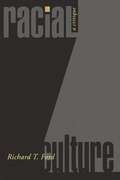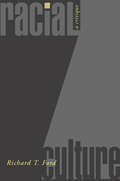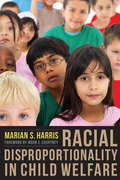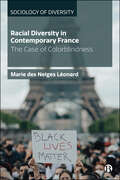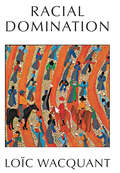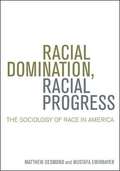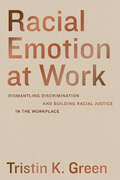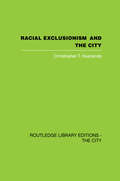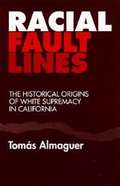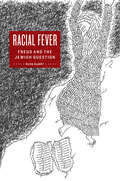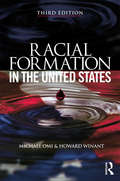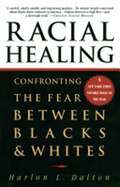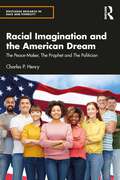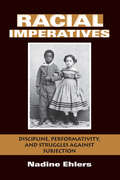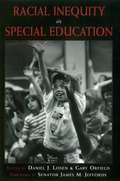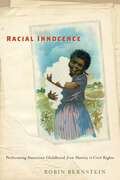- Table View
- List View
Racial Blackness and Indian Ocean Slavery: Iran's Cinematic Archive
by Parisa VaziriRethinking the history of African enslavement in the western Indian Ocean through the lens of Iranian cinema From the East African and Red Sea coasts to the Persian Gulf ports of Bushihr, Kish, and Hurmuz, sailing and caravan networks supplied Iran and the surrounding regions with African slave labor from antiquity to the nineteenth century. This book reveals how Iranian cinema preserves the legacy of this vast and yet long-overlooked history that has come to be known as Indian Ocean slavery. How does a focus on blackness complicate traditional understandings of history and culture? Parisa Vaziri addresses this question by looking at residues of the Indian Ocean slave trade in Iranian films from the second half of the twentieth century. Revealing the politicized clash between commercial cinema (fīlmfārsī) and alternative filmmaking (the Iranian New Wave), she pays particular attention to the healing ritual zār, which is both an African slave descendent practice and a constitutive element of Iranian culture, as well as to cinematic sīyāh bāzī (Persian black play). Moving beyond other studies on Indian Ocean and trans-Saharan slavery, Vaziri highlights the crystallization of a singular mode of historicity within these cinematic examples—one of &“absence&” that reflects the relative dearth of archival information on the facts surrounding Indian Ocean slavery. Bringing together cinema studies, Middle East studies, Black studies, and postcolonial theory, Racial Blackness and Indian Ocean Slavery explores African enslavement in the Indian Ocean through the revelatory and little-known history of Iranian cinema. It shows that Iranian film reveals a resistance to facticity representative of the history of African enslavement in the Indian Ocean and preserves the legacy of African slavery&’s longue durée in ways that resist its overpowering erasure in the popular and historical imagination. Retail e-book files for this title are screen-reader friendly with images accompanied by short alt text and/or extended descriptions.
Racial Blackness and the Discontinuity of Western Modernity
by Dwight A. Mcbride John Carlos Rowe Justin A. Joyce Lindon BarrettThe unfinished manuscript of literary and cultural theorist Lindon Barrett, this study offers a genealogy of how the development of racial blackness within the mercantile capitalist system of Euro-American colonial imperialism was constitutive of Western modernity. Masterfully connecting historical systems of racial slavery to post-Enlightenment modernity, this pathbreaking publication shows how Western modernity depended on a particular conception of racism contested by African American writers and intellectuals from the eighteenth century to the Harlem Renaissance.
Racial Blasphemies: Religious Irreverence and Race in American Literature (Literary Criticism and Cultural Theory)
by Michael L. CobbRacial Blasphemies, using critical race theory and literary analysis, charts the tense, frustrated religious language that saturates much twentieth-century American literature. Michael Cobb argues that we should consider religious language as a special kind of language - a language of curse words - that furiously communicates not theology or spirituality as much as it signals the sheer difficulty of representing race in a non-racist manner on the literary page.
Racial Cities: Governance and the Segregation of Romani People in Urban Europe (Routledge Advances in Sociology)
by Giovanni PickerGoing beyond race-blind approaches to spatial segregation in Europe, Racial Cities argues that race is the logic through which stigmatized and segregated "Gypsy urban areas" have emerged and persisted after World War II. Building on nearly a decade of ethnographic and historical research in Romania, Italy, France and the UK, Giovanni Picker casts a series of case studies into the historical framework of circulations and borrowings between colony and metropole since the late nineteenth century. By focusing on socio-economic transformations and social dynamics in contemporary Cluj-Napoca, Pescara, Montreuil, Florence and Salford, Picker detects four local segregating mechanisms, and comparatively investigates resemblances between each of them and segregation in French Rabat, Italian Addis Ababa, and British New Delhi. These multiple global associations across space and time serve as an empirical basis for establishing a solid bridge between race critical theories and urban studies. Racial Cities is the first comprehensive analysis of the segregation of Romani people in Europe, providing a fine-tuned and in-depth explanation of this phenomenon. While inequalities increase globally and poverty is ever more concentrated, this book is a key contribution to debates and actions addressing social marginality, inequalities, racist exclusions, and governance. Thanks to its dense yet thoroughly accessible narration, the book will appeal to scholars, undergraduate and postgraduate students, postdoctoral researchers, and equally to activists and policy makers, who are interested in areas including: Race and Racism, Urban Studies, Governance, Inequalities, Colonialism and Postcolonialism, and European Studies.
Racial Criminalization of Migrants in the 21st Century (New Advances in Crime and Social Harm)
by Salvatore PaliddaOver the last two decades in the West, there has been a significant increase in the arrest, imprisonment and detention of migrants. The racial criminalization and victimization of migrants and Roma people has led judicial authorities, local governments, the police, mass media and the general population to perceive migrants and 'gypsies' as responsible for a wide range of offences. Taking into consideration the political and cultural conditions that affect and interconnect societies of emigration and immigration, the contributors examine and compare a range of cases in Europe and the United States. The contributions demonstrate how the persecution of the 'current enemy' is the 'total political fact' of the 21st century in that it ensures consensus and business, or what might be termed the 'crime deal' of today. This provocative book has international appeal and will be a valuable resource for academics, researchers and policymakers with an interest in migration and social and ethnic control.
Racial Culture: A Critique
by Richard T. FordWhat is black culture? Does it have an essence? What do we lose and gain by assuming that it does, and by building our laws accordingly? This bold and provocative book questions the common presumption of political multiculturalism that social categories such as race, ethnicity, gender, and sexuality are defined by distinctive cultural practices. Richard Ford argues against law reform proposals that would attempt to apply civil rights protections to "cultural difference." Unlike many criticisms of multiculturalism, which worry about "reverse discrimination" or the erosion of core Western cultural values, the book's argument is primarily focused on the adverse effects of multicultural rhetoric and multicultural rights on their supposed beneficiaries. In clear and compelling prose, Ford argues that multicultural accounts of cultural difference do not accurately describe the practices of social groups. Instead these accounts are prescriptive: they attempt to canonize a narrow, parochial, and contestable set of ideas about appropriate group culture and to discredit more cosmopolitan lifestyles, commitments, and values. The book argues that far from remedying discrimination and status hierarchy, "cultural rights" share the ideological presuppositions, and participate in the discursive and institutional practices, of racism, sexism, and homophobia. Ford offers specific examples in support of this thesis, in diverse contexts such as employment discrimination, affirmative action, and transracial adoption. This is a major contribution to our understanding of today's politics of race, by one of the most distinctive and important young voices in America's legal academy.
Racial Culture: A Critique
by Richard T. FordWhat is black culture? Does it have an essence? What do we lose and gain by assuming that it does, and by building our laws accordingly? This bold and provocative book questions the common presumption of political multiculturalism that social categories such as race, ethnicity, gender, and sexuality are defined by distinctive cultural practices. Richard Ford argues against law reform proposals that would attempt to apply civil rights protections to "cultural difference." Unlike many criticisms of multiculturalism, which worry about "reverse discrimination" or the erosion of core Western cultural values, the book's argument is primarily focused on the adverse effects of multicultural rhetoric and multicultural rights on their supposed beneficiaries. In clear and compelling prose, Ford argues that multicultural accounts of cultural difference do not accurately describe the practices of social groups. Instead these accounts are prescriptive: they attempt to canonize a narrow, parochial, and contestable set of ideas about appropriate group culture and to discredit more cosmopolitan lifestyles, commitments, and values. The book argues that far from remedying discrimination and status hierarchy, "cultural rights" share the ideological presuppositions, and participate in the discursive and institutional practices, of racism, sexism, and homophobia. Ford offers specific examples in support of this thesis, in diverse contexts such as employment discrimination, affirmative action, and transracial adoption. This is a major contribution to our understanding of today's politics of race, by one of the most distinctive and important young voices in America's legal academy.
Racial Discrimination: Institutional Patterns and Politics (Routledge Research in Race and Ethnicity)
by Masoud KamaliThere is an institutionalized dilemma in Europe that counteracts social cohesion and stability. It is a result of the collision and incompatibility between declarations of universal values (such as human rights and democracy) and institutionalized actions which exclude and discriminate against Europeans of immigrant background and against ethnic minorities. This book analyzes the institutional patterns and politics of ‘racial’ discrimination in modern-day Europe. Based on a research project that has been carried out under the leadership of the author in eight European countries, Racial Discrimination seeks the answers to some of the key questions posed by the latest developments in European political and public spheres concerning immigration and the increase in xenophobic sentiments and parties. The book will appeal to all social and political scientists interested in the latest political developments in Europe and in the problems of democratic citizenship and the efforts to move toward an integrated European community.
Racial Disproportionality and Disparities in the Child Welfare System (Child Maltreatment #11)
by Alan J. DettlaffThis volume examines existing research documenting racial disproportionality and disparities in child welfare systems, the underlying factors that contribute to these phenomena and the harms that result at both the individual and community levels. It reviews multiple forms of interventions designed to prevent and reduce disproportionality, particularly in states and jurisdictions that have seen meaningful change. With contributions from authorities and leaders in the field, this volume serves as the authoritative volume on the complex issue of child maltreatment and child welfare. It offers a central source of information for students and practitioners who are seeking understanding on how structural and institutional racism can be addressed in public systems.
Racial Disproportionality in Child Welfare
by Marian HarrisThe number of children of color entering the child welfare system in the United States is disproportionately high. Not only are children of color removed from parental custody and placed in care more often than their white counterparts, but they also remain in care longer, receive fewer services, and have less contact with the caseworkers assigned to them. This book identifies the practice and policy changes required to successfully address the unequal treatment of children of color in the child welfare system and their implications for social work education, caseworker training, and institutional change. It critiques many of the existing social welfare acts and policies in terms of their treatment of children of color, and it provides best practices for each decision point in the child welfare process and for cultural competency measures and training. The text offers extensive measurement instruments that agencies can use to assess and correct institutional racism. To improve social work education, the book includes several model syllabi for the curriculum, and to deepen the discipline's engagement with the issue of institutional racism, the text concludes with a discussion of future directions for research and policy.
Racial Diversity in Contemporary France: The Case of Colorblindness (Sociology of Diversity)
by Marie Neiges LéonardThis book offers a unique perspective on contemporary France by focusing on racial diversity, race, and racism as central features of French society and identity. Marie des Neiges Léonard critically reviews contentious public policies and significant issues, including reactions to the terrorist attack against satirical magazine Charlie Hebdo and policies regarding the Islamic veil, revealing how color-blind racism plays a role in the persistence of racial inequality for French racial minorities. Drawing from American sociological frameworks, this outstanding study presents a new way of thinking in the study of racial identity politics in today’s France.
Racial Domination
by Loïc WacquantRace is arguably the single most troublesome and volatile concept of the social sciences in the early 21st century. It is invoked to explain all manner of historical phenomena and current issues, from slavery to police brutality to acute poverty, and it is also used as a term of civic denunciation and moral condemnation. In this erudite and incisive book based on a panoramic mining of comparative and historical research from around the globe, Loïc Wacquant pours cold analytical water on this hot topic and infuses it with epistemological clarity, conceptual precision, and empirical breadth.Drawing on Gaston Bachelard, Max Weber, and Pierre Bourdieu, Wacquant first articulates a series of reframings, starting with dislodging the United States from its Archimedean position, in order to capture race-making as a form of symbolic violence. He then forges a set of novel concepts to rethink the nexus of racial classification and stratification: the continuum of ethnicity and race as disguised ethnicity, the diagonal of racialization and the pentad of ethnoracial domination, the checkerboard of violence and the dialectic of salience and consequentiality. This enables him to elaborate a meticulous critique of such fashionable notions as “structural racism” and “racial capitalism” that promise much but deliver little due to their semantic ambiguity and rhetorical malleability—notions that may even hamper the urgent fight against racial inequality.Wacquant turns to deploying this conceptual framework to dissect two formidable institutions of ethnoracial rule in America: Jim Crow and the prison. He draws on ethnographies and historiographies of white domination in the postbellum South to construct a robust analytical concept of Jim Crow as caste terrorism erected in the late 19th century. He unravels the deadly symbiosis between the black hyperghetto and the carceral archipelago that has coproduced and entrenched the material and symbolic marginality of the African-American precariat in the metropolis of the late 20th century. Wacquant concludes with reflections on the politics of knowledge and pointers on the vexed question of the relationship between social epistemology and racial justice.Both sharply focused and wide ranging, synthetic yet controversial, Racial Domination will be of interest to students and scholars of race and ethnicity, power and inequality, and epistemology and theory across the social sciences and humanities.
Racial Domination, Racial Progress: The Sociology of Race in America
by Mustafa Emirbayer Matthew DesmondThe book looks at race in a clear and accessible way, allowing students to understand how racial domination and progress work in all aspects of society.
Racial Emotion at Work: Dismantling Discrimination and Building Racial Justice in the Workplace
by Tristin K. GreenThis timely book unravels race and emotion in the workplace—exploring why racial emotion is often left out of equity conversations and why we must confront it.Racial Emotion at Work is an invitation to understand our own emotions and associated behaviors around race—and much more. With this surprising and timely book, Tristin K. Green takes us beyond diversity trainings and other individualized solutions to discrimination and inequality in employment, calling for sweeping changes in how the law and work organizations treat and shape racial emotions. Green provides readers with the latest research on racial emotions in interracial interactions and ties this research to thinking about discrimination and disadvantage at work. We see how our racial emotions can result in discrimination, and how our institutions—the law and work organizations—value and skew our racial emotions in ways that place the brunt of negative consequences on people of color. It turns out we need to reset our institutional and not just our personal radars on racial emotion to advance racial justice. Racial Emotion at Work shows how we can rise to the task.
Racial Exclusionism and the City: The Urban Support of the National Front
by Christopher T. HusbandsFirst published in 1983, this book reports on the results of a survey in thirteen areas of England where the National Front (NF) had previously gained significant levels of electoral support and examines the social and political histories of these areas to reveal not only who and was voting for the NF in the 1970s but also why.
Racial Fault Lines: The Historical Origins of White Supremacy in California
by Tomás AlmaguerThis book unravels the ethnic history of California since the late nineteenth-century Anglo-American conquest and institutionalization of "white supremacy" in the state. Almaguer comparatively assesses the struggles for control of resources, status, and political legitimacy between the European American and the Native American, Mexican, African-American, Chinese, and Japanese populations. Drawing from an array of primary and secondary sources, he weaves a detailed, disturbing portrait of ethnic, racial, and class relationships during this tumultuous time. The U. S. annexation of California in 1848 and the simultaneous discovery of gold sparked rapid and diverse waves of immigration westward, displacing the already established pastoral Mexican society. Almaguer shows how the confrontation between white immigrants and the Mexican ranchero and working class populations was also a contestation over racial status in which racialization influenced and was in turn influenced by class position in the changing economic order. Partly because of the Treaty of Guadalupe Hidalgo, which granted U. S. citizenship and other rights, parts of the Mexican population were integrated into the emerging Anglo society more easily than other racialized groups. A case study of Ventura County highlights declining political and economic fortunes of the Mexican elite while showing how Mexican, Japanese, Chinese, and Indian populations were permanently relegated to the bottom of the class structure as unskilled manual workers. The fate of the Native American population provides perhaps the most extreme example of white supremacy during the period. Popular conceptions of Native Americans as "uncivilized and "heathen," justified the killing of more than 8,000 men, women, and children between 1848 and 1870. Many survivors were incorporated at the periphery of Anglo society, often as indentured laborers and virtual slaves. Underpinning the institutional structuring of white supremacy were notions such as "manifest destiny," the inherent good of the capitalist wage-system, and the superiority of Christianity and Euro-American culture, all of which helped to marginalize non white groups in California and justify Anglo-American class dominance. As other racialized groups assumed new roles, Almaguer assesses the complex interplay between economic forces and racial attitudes that simultaneously structured and allocated "group position" in the new social hierarchy. California remains a contested racial frontier, as political struggles over the rights and opportunities of different groups continue to reverberate along racial lines. Racial Fault Lines is an invaluable contribution to our understanding of ethnicity and class in America, and the social construction of "race" in the Far West.
Racial Fever: Freud and the Jewish Question
by Eliza SlavetWhat makes a person Jewish? Why do some people feel they have physically inherited the memories of their ancestors? Is there any way to think about race without reducing it to racism or to physical differences?These questions are at the heart of Racial Fever: Freud and the Jewish Question. In his final book, Moses and Monotheism, Freud hinted at the complexities of Jewishness and insisted that Moses was really an Egyptian. Slavet moves far beyond debates about how Freud felt about Judaism; instead, she explores what he wrote about Jewishness: what it is, how it is transmitted, and how it has survived. Freud’s Moses emerges as the culmination of his work on transference, telepathy, and intergenerational transmission, and on the relationships between memory and its rivals: history, heredity, and fantasy. Writing on the eve of the Holocaust, Freud proposed that Jewishness is constituted by the inheritance of ancestral memories; thus, regardless of any attempts to repress, suppress, or repudiate Jewishness, Jews will remain Jewish and Judaism will survive, for better and for worse.
Racial Formation in the Twenty-First Century
by Daniel Martinez Hosang Laura Pulido Oneka LabennettMichael Omi and Howard Winant's Racial Formation in the United States remains one of the most influential books and widely read books about race. Racial Formation in the 21st Century, arriving twenty-five years after the publication of Omi and Winant's influential work, brings together fourteen essays by leading scholars in law, history, sociology, ethnic studies, literature, anthropology and gender studies to consider the past, present and future of racial formation. The contributors explore far-reaching concerns: slavery and land ownership; labor and social movements; torture and war; sexuality and gender formation; indigineity and colonialism; genetics and the body. From the ecclesiastical courts of seventeenth century Lima to the cell blocks of Abu Grahib, the essays draw from Omi and Winant's influential theory of racial formation and adapt it to the various criticisms, challenges, and changes of life in the twenty-first century.
Racial Formation in the United States
by Howard Winant Michael OmiTwenty years since the publication of the Second Edition and more than thirty years since the publication of the original book, Racial Formation in the United States now arrives with each chapter radically revised and rewritten by authors Michael Omi and Howard Winant, but the overall purpose and vision of this classic remains the same: Omi and Winant provide an account of how concepts of race are created and transformed, how they become the focus of political conflict, and how they come to shape and permeate both identities and institutions. The steady journey of the U.S. toward a majority nonwhite population, the ongoing evisceration of the political legacy of the early post-World War II civil rights movement, the initiation of the 'war on terror' with its attendant Islamophobia, the rise of a mass immigrants rights movement, the formulation of race/class/gender 'intersectionality' theories, and the election and reelection of a black President of the United States are some of the many new racial conditions Racial Formation now covers.
Racial Healing: Confronting the Fear Between Blacks and Whites
by Harlon L. DaltonGoing against conventional wisdom, Dalton asserts that blacks and whites need not live estranged, and offers concrete proposals for what individual blacks and whites must do to bring about racial healing. <p><p> When discussing race, Dalton suggests that blacks and whites "should simply put everything on the table. Own up to the tension. Acknowledge the risks. When someone inevitably screws up, rather than beat a hasty retreat, we should seize the opportunity to deepen the dialogue." <p><p> The unflinching honesty of Dalton's views will spark debate and controversy. His vision of a truly just, multicultural America provides a thought-provoking, hopeful view to add to the diversity of debate over race.
Racial Identities, Genetic Ancestry, and Health in South America
by Ricardo Ventura Santos Sahra Gibbon Mónica SansThe edited collection brings together social and biological anthropology scholars, biologists, and geneticists to examine the interface between Genetic Admixture, Identity and Health, directly contributing to an emerging field of 'bio-cultural anthropology. ' It focuses on the neglected region of South America with scientific and social science contributions from Brazil, Columbia, Argentina, and Uruguay and commentaries from leading experts in the UK and the United States. As such the collection contributes to the urgent task of nurturing and advancing a cross disciplinary community that can address and examine a topical set of theoretical issues, brought about by the rapidly changing field of genetic science.
Racial Imagination and the American Dream: The Peace-Maker, The Prophet and The Politician (Routledge Research in Race and Ethnicity)
by Charles P. HenryAlthough the phrase "the American Dream" dates from the 1930s, the concept or idea of the American Dream is as old as the country. The values proclaimed in the Declaration of Independence and reaffirmed (and extended) in the Gettysburg Address have been continuously promoted by every American president. Moreover, they form the basis of our national collective narrative as expressed through both elite and popular culture. The American Dream is intrinsically tied to the American Creed and American Exceptionalism. It is the foundation of our national identity, the glue that holds together our individual aspirations. Yet until the mid-twentieth century, the American Dream excluded African Americans. We as a nation—as an imagined community—could not imagine an integrated, multiracial society with Blacks and Whites living together as equals. By examining the lives of the only three African American Nobel Peace Prize winners, we can see how their lives were shaped by the American Dream, and how their success was used to deny the structural racism that prevented others from achieving the American Dream. Ralph Bunche as a role model of academic and technical expertise, Martin Luther King, Jr., as a model race leader, and Barack Obama as a political leader provide a window on the changing meaning of the American Dream. In conclusion, Haiti is presented as a failed example of an attempt to export the American Dream in the form of American Exceptionalism, and racial reparations are reimagined as a radical democratic project aimed at true global integration and justice.
Racial Imperatives: Discipline, Performativity, and Struggles Against Subjection
by Nadine EhlersAn examination of the constructs of race in contemporary American society.Nadine Ehlers examines the constructions of blackness and whiteness cultivated in the US imaginary and asks, how do individuals become racial subjects? She analyzes anti-miscegenation law, statutory definitions of race, and the rhetoric surrounding the phenomenon of racial passing to provide critical accounts of racial categorization and norms, the policing of racial behavior, and the regulation of racial bodies as they are underpinned by demarcations of sexuality, gender, and class. Ehlers places the work of Michel Foucault, Judith Butler’s account of performativity, and theories of race into conversation to show how race is a form of discipline, that race is performative, and that all racial identity can be seen as performative racial passing. She tests these claims through an excavation of the 1925 “racial fraud” case of Rhinelander v. Rhinelander and concludes by considering the possibilities for racial agency, extending Foucault’s later work on ethics and “technologies of the self” to explore the potential for racial transformation.“In Racial Imperatives Nadine Ehlers explores the idea that racial identity is a construct both performed by individuals and maintained by the law. . . . [Raises] interesting ideas, particularly that “all identity is a form of passing,” and that all subjects . . . must continually enact their racial identities.” —Journal of American History, June 2015“[T]his project fills a major gap in both Critical Race and Foucault studies. It will undoubtedly be cited and engaged for years to come.” —Critical Philosophy of Race“Racial Imperatives is a strong tome with a great deal of value across disciplines. Building on her previous scholarly investigations and relying on a robust scholarship to push intellectual boundaries, Ehlers’s work is insightful and thought provoking. . . . Scholars that study race in any academic discipline would benefit from the ideas and analysis in this book.” —Spectrum
Racial Inequity in Special Education
by Gary Orfield Daniel J. LosenAn illuminating account of a widespread problem that has received little attention, Racial Inequity in Education sets the stage for a more fruitful discussion about special education and racial justice.
Racial Innocence: Performing American Childhood from Slavery to Civil Rights (America and the Long 19th Century #16)
by Robin Bernstein2013 Book Award Winner from the International Research Society in Children's Literature2012 Outstanding Book Award Winner from the Association for Theatre in Higher Education 2012 Winner of the Lois P. Rudnick Book Prize presented by the New England American Studies Association 2012 Runner-Up, John Hope Franklin Publication Prize presented by the American Studies Association2012 Honorable Mention, Distinguished Book Award presented by the Society for the Study of American Women WritersDissects how "innocence" became the exclusive province of white children, covering slavery to the Civil Rights eraBeginning in the mid nineteenth century in America, childhood became synonymous with innocence—a reversal of the previously-dominant Calvinist belief that children were depraved, sinful creatures. As the idea of childhood innocence took hold, it became racialized: popular culture constructed white children as innocent and vulnerable while excluding black youth from these qualities. Actors, writers, and visual artists then began pairing white children with African American adults and children, thus transferring the quality of innocence to a variety of racial-political projects—a dynamic that Robin Bernstein calls “racial innocence.” This phenomenon informed racial formation from the mid nineteenth century through the early twentieth. Racial Innocence takes up a rich archive including books, toys, theatrical props, and domestic knickknacks which Bernstein analyzes as “scriptive things” that invite or prompt historically-located practices while allowing for resistance and social improvisation. Integrating performance studies with literary and visual analysis, Bernstein offers singular readings of theatrical productions from blackface minstrelsy to Uncle Tom’s Cabin to The Wonderful Wizard of Oz; literary works by Joel Chandler Harris, Harriet Wilson, and Frances Hodgson Burnett; material culture including Topsy pincushions, Uncle Tom and Little Eva handkerchiefs, and Raggedy Ann dolls; and visual texts ranging from fine portraiture to advertisements for lard substitute. Throughout, Bernstein shows how “innocence” gradually became the exclusive province of white children—until the Civil Rights Movement succeeded not only in legally desegregating public spaces, but in culturally desegregating the concept of childhood itself.
